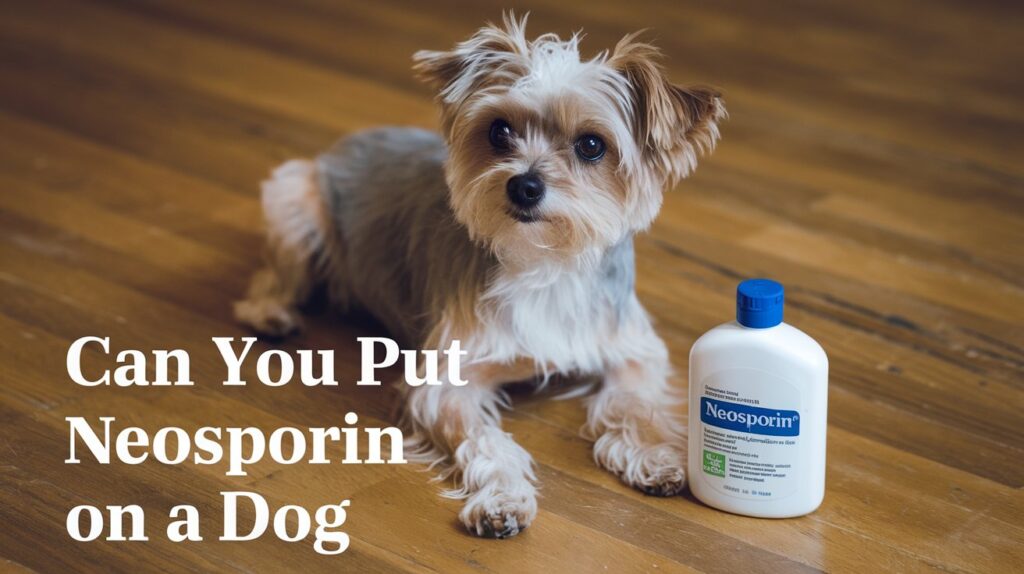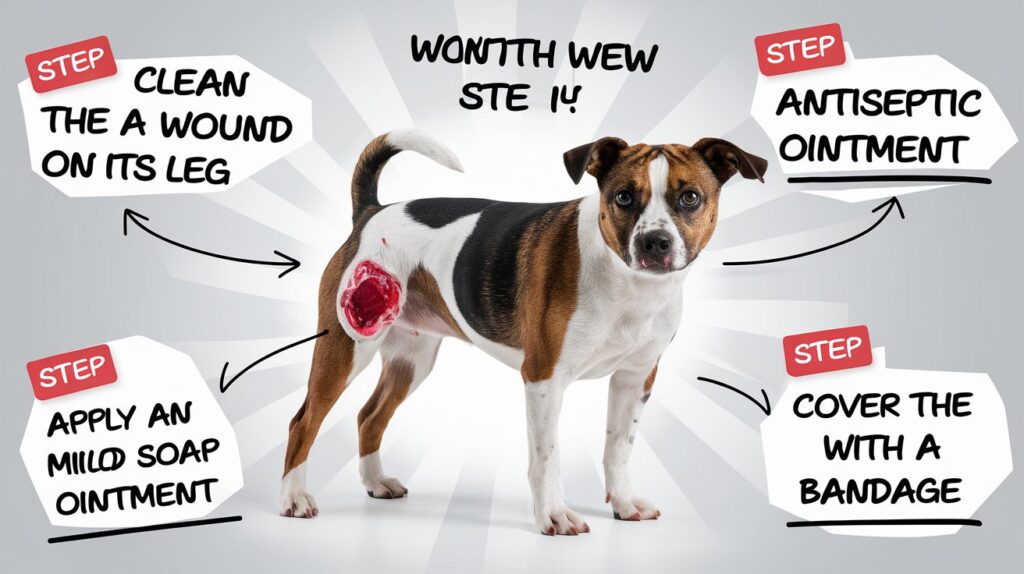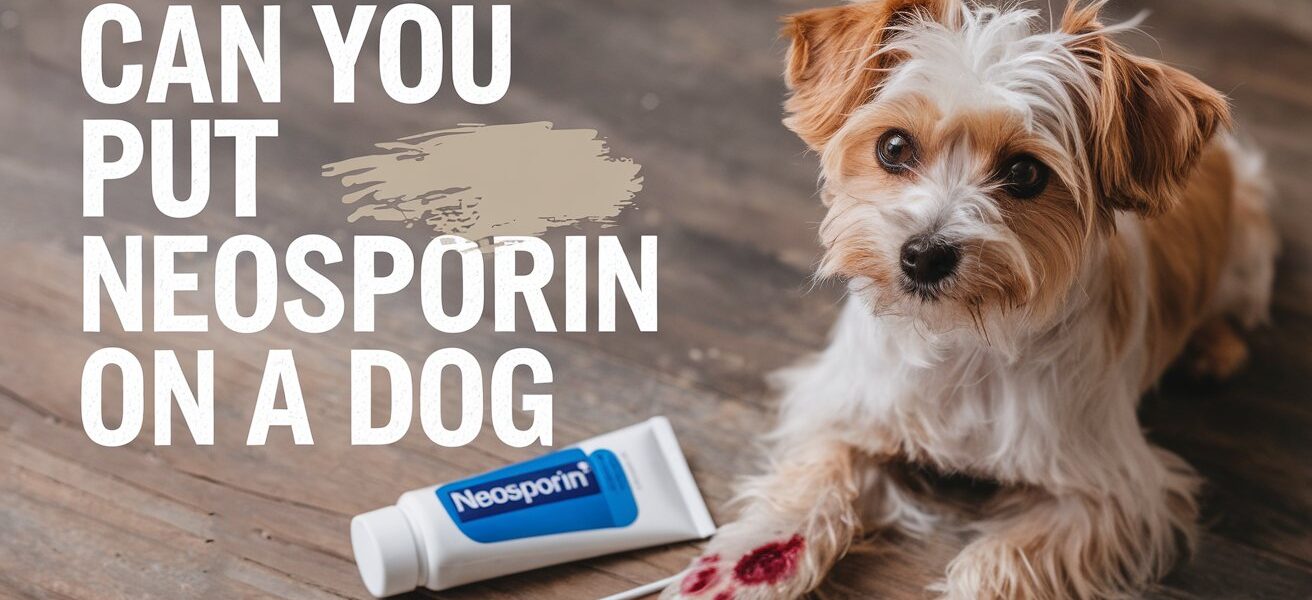- Homepage
- Health Disorders & Cure
- Can You Put Neosporin on a Dog? A Safe and Effective Solution for Minor Wounds
Can You Put Neosporin on a Dog? A Safe and Effective Solution for Minor Wounds

Table of Contents
ToggleCan You Put Neosporin on a Dog?
Yes, you can put Neosporin on a dog for minor cuts, scrapes, or abrasions, but it should be used carefully. Apply a small amount of the ointment to superficial wounds, ensuring the area is clean before application. Since dogs tend to lick their wounds, it’s important to prevent this, as ingesting Neosporin can cause stomach upset, such as vomiting or diarrhea. Using an Elizabethan collar (cone) can help stop your dog from licking the treated area. For deep wounds, infections, or allergic reactions, it’s best to consult a veterinarian before using Neosporin.
What is Neosporin?
Neosporin is a topical antibiotic that contains three active ingredients: bacitracin, neomycin, and polymyxin B. It is commonly used in humans to treat minor cuts, scrapes, and burns, preventing infection while aiding in the healing process. The bacteria that cause infections are killed by these Antibiotics.
Is Neosporin Safe for Dogs?
While Neosporin is generally safe for humans, using it on dogs comes with its own set of concerns. Neosporin can be applied to dogs, but only under specific conditions. It’s important to note that dogs have different skin structures and sensitivities compared to humans, which makes applying any medication to their skin a careful process. Neosporin is safe in small amounts for superficial wounds, but we must exercise caution.
When is it Safe to Use Neosporin on a Dog?
Neosporin can be used on a dog for minor skin injuries like small cuts, scrapes, or abrasions. However, the wound should be superficial and not infected. Before applying Neosporin, clean the wound thoroughly with water and a gentle antiseptic solution. Once the area is dry, a thin layer of Neosporin can be applied to the wound. Always ensure that the wound is not too deep, as deeper wounds may require veterinary attention.
When You Should Avoid Using Neosporin on Dogs
While Neosporin can be beneficial for minor injuries, it’s not always the best choice for more serious conditions. We strongly advise against using Neosporin on the following types of wounds:
- Deep or puncture wounds: These wounds are at higher risk of infection and should be assessed by a veterinarian.
- Infected wounds: Neosporin is not a solution for infections that have already set in.
- Large open wounds: Larger wounds often require specialized care, including sutures or bandaging, which Neosporin alone cannot provide.
- Allergic reactions: If your dog shows signs of an allergic reaction, such as redness, swelling, or hives after applying Neosporin, discontinue use immediately.
Risks and Side Effects of Neosporin on Dogs
One of the major risks of applying Neosporin to a dog is that dogs tend to lick their wounds. Ingesting Neosporin is not ideal, as it can cause gastrointestinal upset, including nausea, vomiting, and diarrhea. To prevent this, you can use an Elizabethan collar (also known as a cone) to stop the dog from licking the treated area.
Some dogs may also experience allergic reactions to the ingredients in Neosporin, leading to skin irritation or an increase in redness around the wound. It’s always important to monitor your dog closely after applying any topical medication.
Alternatives to Neosporin for Dogs
If you’re concerned about using Neosporin on your dog, there are safer alternatives specifically designed for canine care:
1. Veterinary-prescribed ointments: Your veterinarian can prescribe an ointment specifically formulated for pets that may be safer and more effective.
2. Natural options: Some dog owners prefer to use natural remedies like aloe vera gel or manuka honey, which can also help with wound healing and have natural antibacterial properties.
3. Pet-safe wound care products: There are numerous pet-safe products available, such as Vetericyn or Derma Gel, that are made specifically for treating wounds on dogs and other animals.

How to Properly Care for Your Dog’s Wound
Caring for your dog’s wound goes beyond just applying Neosporin or any other treatment. Here’s a step-by-step guide on how to provide the best care for a minor injury:
1. Clean the wound: Gently rinse the wound with lukewarm water. If necessary, use a mild antiseptic solution recommended for pets.
2. Trim the fur around the wound: If your dog has a lot of fur, you may need to carefully trim it away from the wound to keep the area clean.
3. Apply the treatment: Use a small amount of Neosporin (or an alternative) to the clean wound, ensuring that you do not over-apply the ointment.
4. Prevent licking: As mentioned earlier, dogs often lick their wounds, so it’s important to prevent this by using a cone or some form of barrier.
5. Monitor for signs of infection: Keep an eye on the wound for any signs of worsening, such as swelling, pus, or heat. If any of these occur, take your dog to the vet.
When to Seek Veterinary Help
In some cases, your dog’s wound may need professional care. If the injury appears to be deep, shows signs of infection, or your dog is in a significant amount of pain, it’s best to consult with a veterinarian. In addition, if your dog is constantly licking the wound and you’re unable to prevent it, this may delay healing and increase the risk of infection.
You should also seek veterinary care if:
- The wound is bleeding excessively.
- Your dog becomes lethargic or shows signs of fever.
- There is a foul smell coming from the wound.
Conclusion: Can You Put Neosporin on a Dog?
In conclusion, Neosporin can be used on dogs in small amounts for minor injuries, but it is essential to take the necessary precautions and monitor your dog closely. If in doubt, or if your dog has a more serious injury, always consult your veterinarian for the best advice. Neosporin may not always be the best option, especially when pet-safe alternatives are available.
FAQs: Can You Put Neosporin on a Dog
1. Can I put human Neosporin on my dog?
Yes, you can use Neosporin on minor cuts and scrapes, but only in small amounts and for superficial wounds. Always consult your vet if unsure.
2. What antibiotic ointment is safe for dogs?
Ointments like Vetericyn, Derma Gel, or vet-prescribed antibiotics are safer options specifically made for dogs.
3. What happens if my dog licks the Neosporin?
If a dog licks Neosporin, it can cause stomach upset, including vomiting or diarrhea. It’s best to prevent licking with a cone.
4. Can you use Vaseline or Neosporin on dogs?
Neosporin can be used for minor wounds, but Vaseline is not an antibiotic and is less effective. Always consult your vet for proper treatment.

Jahanzaib Kaleem is a passionate and knowledgeable pet writer and veterinarian dedicated to enhancing the well-being of pets and educating pet owners around the world. With years of experience in veterinary medicine and a deep love for animals, Jahanzaib combines his medical expertise with a flair for writing to deliver insightful and practical advice on pet care.





